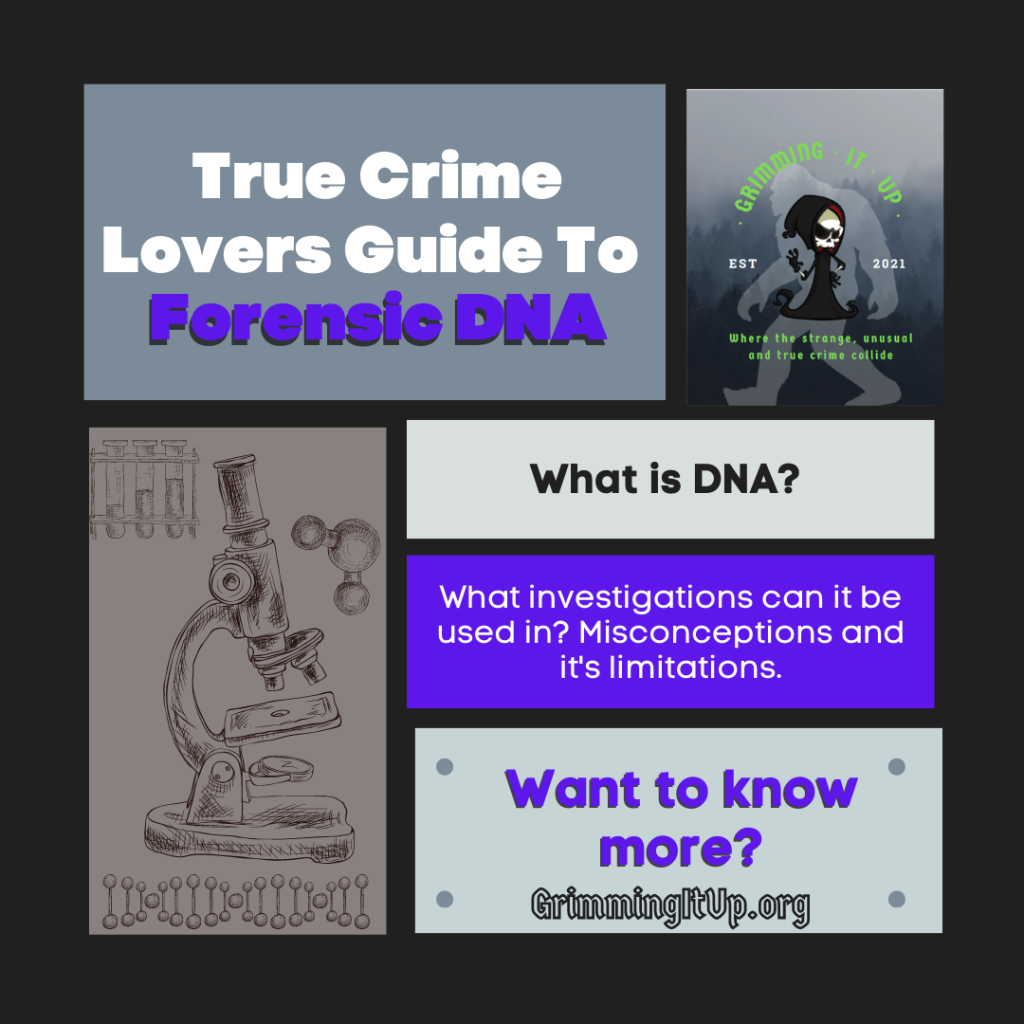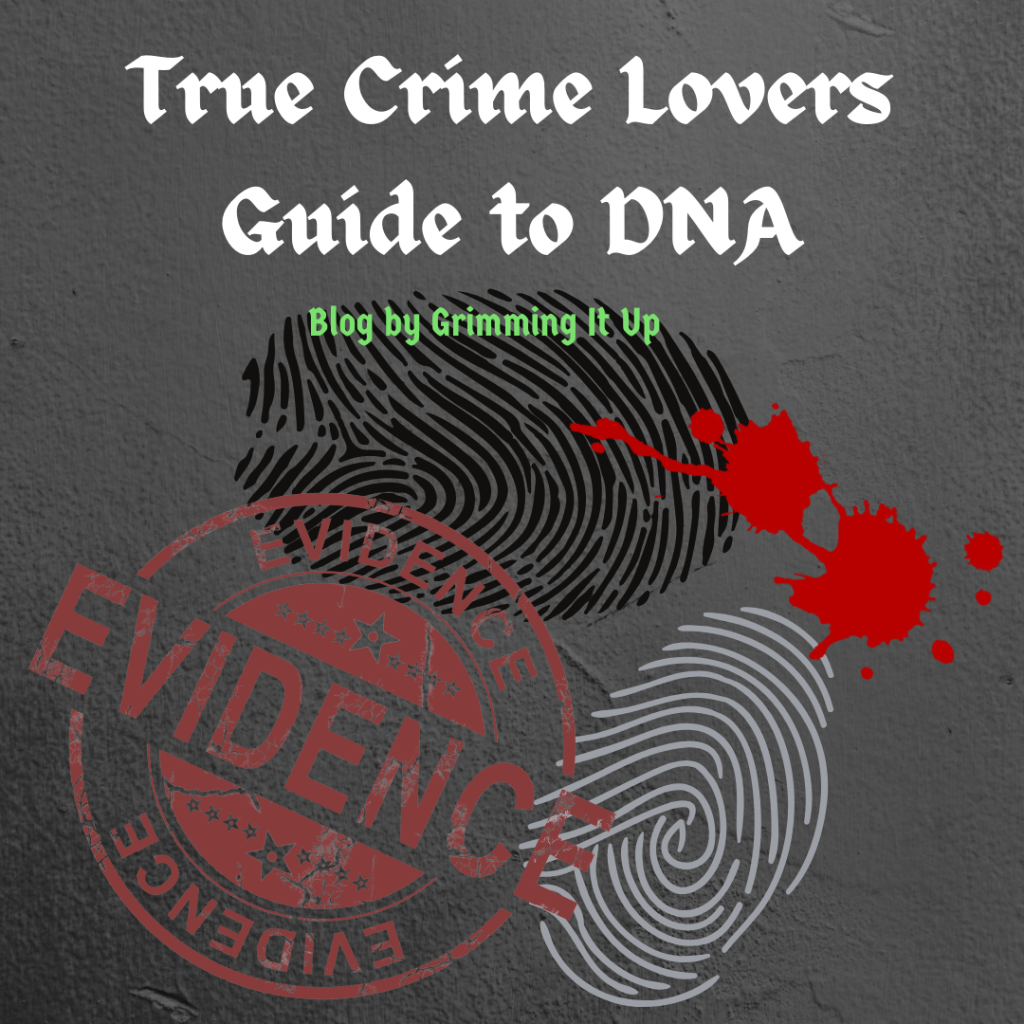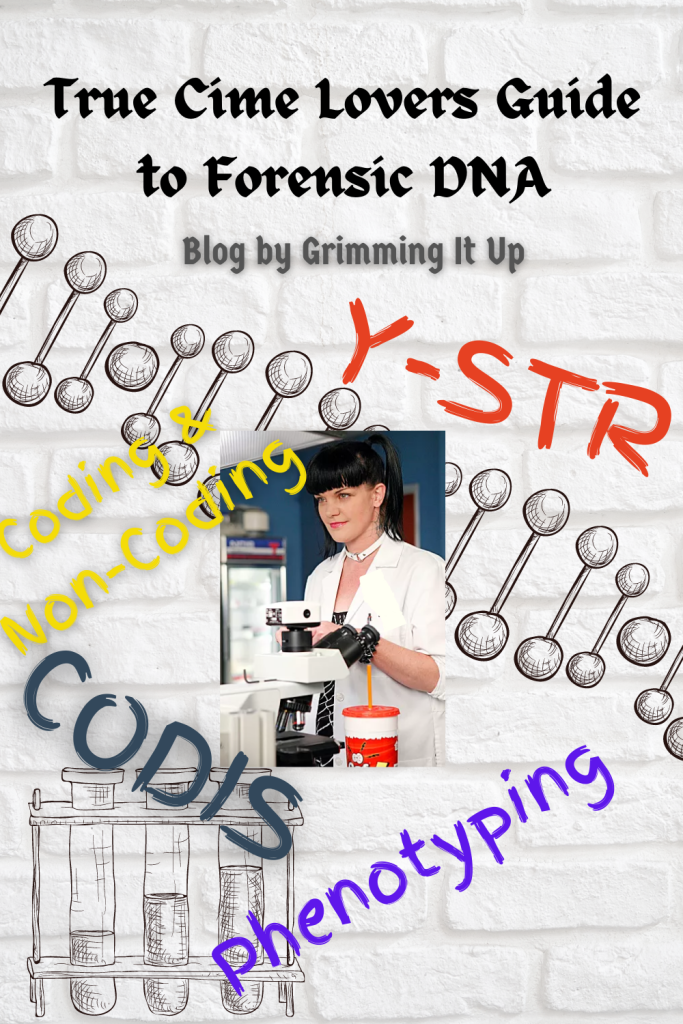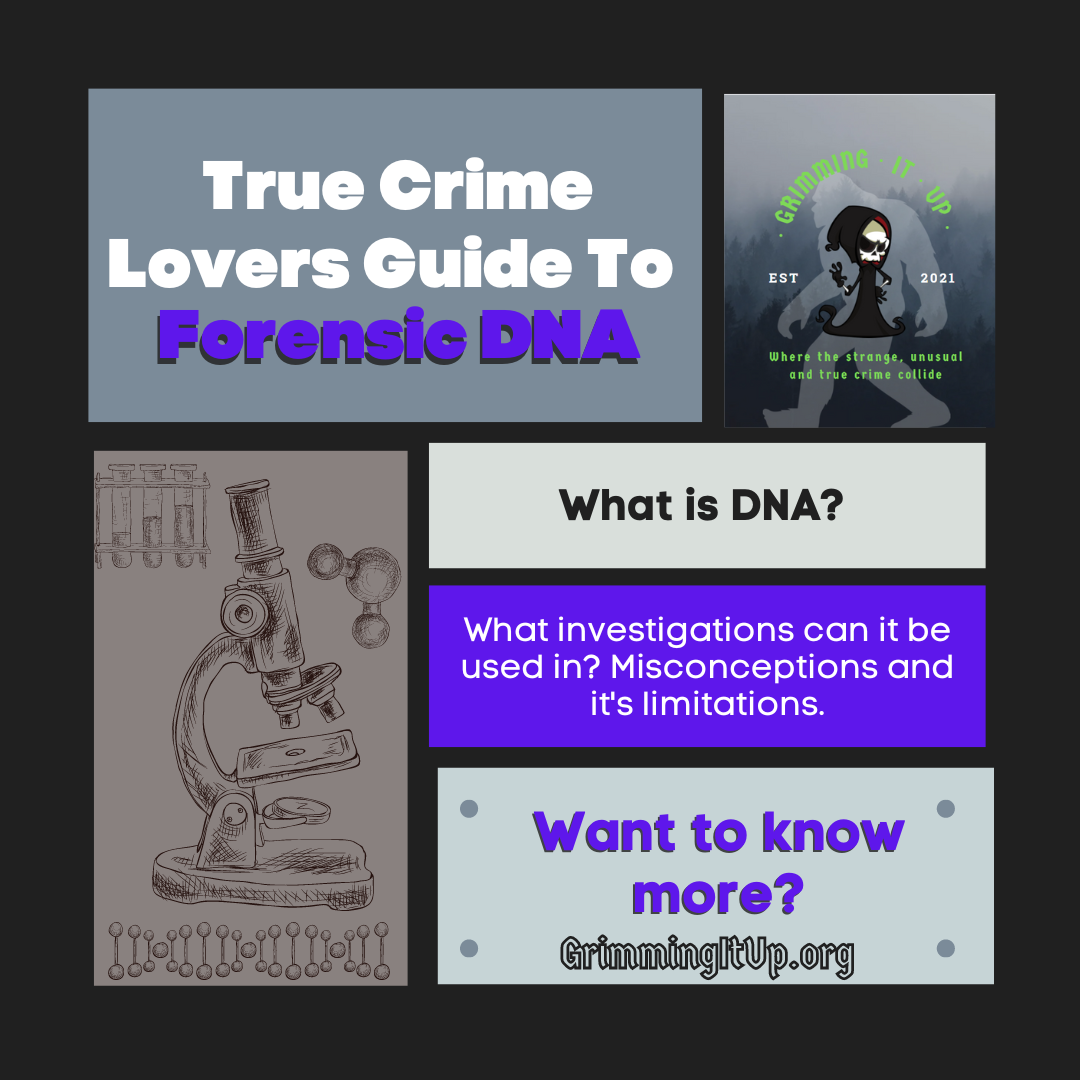
Have you ever watched a movie or read a book saying that the killer was caught by DNA evidence? Hollywood uses vocabulary like “DNA evidence” as a catchall.
What is DNA exactly? DNA stands for deoxyribonucleic acid, and it’s the molecule that carries the genetic material found in all living organisms.
Why do we hear about it changing through the years? I have often wondered about these things myself. I figured I would share some of my research in hopes that it might help others to have a deeper understanding of this topic and what this means. Perhaps familiarizing y’all will make your podcast listening, movie watching, and true-crime blog reading more entertaining.
How Did We Identify Before DNA?

Before the 1980s, investigators performed blood typing tests to help include or exclude individuals. Austrian researcher Karl Landsteiner discovered blood typing in 1900. It was found that 42% of the population have type A blood, 12% have type B, 3% have type AB, and 43% have type O blood. These blood types were often used in paternity disputes. Sometimes for forensic purposes in the United States and Europe.
Blood typing would progress to also include MN and Rhesus (Rh) factors, with antigen-antibody interactions with immunological assays. Next, protein profiling was further developed in the 1980s. This began allowing investigators to differentiate between questionable and known blood samples. There was a downside to the protein testing: it was unstable and not as varied as the current genetic code for forensic investigations. I don’t want to go too far into laboratory geek speak. I am trying to keep this digestible for everyone. If you would like more on this part, please visit some of the sources at the end of the post.
Outcomes Of Testing
Inclusion, exclusion, and inconclusive are the only results on DNA reports. Inclusion, or a match, means the identical genotypes (genetic constitution) are on the STR (short tandem repeat) profiles. Exclusion, or a nonmatch, implies that the genotypes within the profiles are different, which means the sources aren’t the same person. If the result is inconclusive is only applied to mean two things. The first explanation is there isn’t enough information to form a conclusion. The second reason for an inconclusive result would be if the analysts disagree with the review process.
Where to Find DNA
Investigators collect items that a criminal may have touched or worn.
| Masks | Hats | Gloves | Clothing |
| Tools | Weapons | Sexual assault evidence kits | Underclothes |
| Bedding | Dirty laundry | Cups/bottles | Cigarettes |
| Toothpicks | Toothbrush | Facial tissue | Hairbrush |
| Eyeglasses | Condoms | Stamps or envelopes | Blood spatter |
| Tape | Victim’s body (touch DNA) | Ligatures (ropes, wire, cords) |
It’s time to talk about sources of DNA. Investigators are looking for biological material from which to extract genetic profiles. Sources include bone, blood, feces, hair, saliva, semen, teeth, tissue, and cells. True crime fans are familiar with investigators picking up cigarette butts from around crime scenes; they’re looking for saliva to extract genetic material from. Digging through the trash could result in facial tissue, soda bottles, and even a murder weapon. Okay, the last one was added in for comedic effect. But you never know . . .
Let’s look at knives as an example. It wouldn’t only have the victim’s blood on it. If there were multiple stab wounds, there is a high probability that the knife would have the perpetrator’s blood as well. Stabbing people is a messy business. The perpetrator’s grip could slip on the victim’s blood, causing them to get cut too!
In this instance, forensic testing of the knife is admitted as evidence. Forensic workers collect elimination samples from workers at the scene. People who are known to be in the area. An example of people to be excluded are police officers, paramedics, family members, roommates, or even the victim. Eliminating the known samples moves the focus closer to singling out the unknowns.
The DNA Processes
Extraction is the process of releasing the genetic profile from the cell. Quantitation is determining how much genetic material you have. Amplification is the process of producing multiple copies of the DNA to characterize it. Separation is deactivating amplified DNA products to permit subsequent identification. Analysis and interpretation are the processes of quantitatively and qualitatively comparing genetic material evidence samples to known DNA profiles. Quality assurance is the process of reviewing analysts’ reports for technical accuracy.
Partial DNA
If any alleles (variations of a gene) are missing, this is a partial profile. These partial profiles happen for various reasons, and the sample degraded. Environmental factors such as a body or a knife submerged in water for a very long time can also cause DNA to break down. Depending on the water source, its temperature, and things like that, bacteria can cause the genetic material to degrade quickly. Partial DNA is used in criminal cases to include or exclude a suspect or person involved in the case.
Misconceptions

One misconception about DNA evidence can be blamed on popular crime TV and movies. An investigator has processed and given the DNA test results, and suddenly, a suspect’s driver’s license appears. That would be complete Hollywood! In real life, no personal information is listed in the CODIS (Combined DNA Index System) database.
A second misconception is comparing a profile in a state data bank typically takes weeks, not minutes. In the state data banks, the profiles are continuously compared against new profiles as they’re entered. The state system is constantly checking for matches and updates. Even today, this comparison is more prolonged than a few minutes.
The next misunderstanding would be that the technology exists to analyze samples with only trace amounts of DNA in FBI databases. This often isn’t enough to meet the requirements to be entered into the national level of CODIS.
The last misconception I will leave y’all with is around dealing with blood evidence. It is often implied the gene evidence is extracted from red blood cells. This isn’t so. TV shows usually have a centrifuge in their label scenes. Very rarely is it explained why it would be needed. A centrifuge separates the red blood cells from the white blood cells. We can only get DNA from white blood cells. Human red blood cells don’t have a nucleus.
When Is Genetic Evidence Examined?
Violent crimes like homicide or sexual assaults are cases where DNA evidence is vital. Genetic material is found in things like blood, semen, and saliva left behind, and it can link different people to places and/or potentially the victims of these crimes.
Biological evidence—DNA—is also collected for robberies and missing and unidentified people.
Of course, with the advancement of DNA evidence being admissible in court, this has also led to the exoneration of those wrongfully convicted. Especially when DNA analysis was either non-existent or rudimentary at the time of conviction. In 1992, the Innocence Project started at the Benjamin Cardoza School of Law in New York. There isn’t an immediate release of prisoners for unmatched genetic material. Instead, the release is contingent upon finding the guilty person or solid grounds for a new trial.
Oddly enough, when DNA analysis isn’t presented in a trial, lawyers must now explain why it wasn’t. An assault (physical fight) between two people who live together is a great illustration of this. All parties to the crime are known to investigators. For a family assault, it wouldn’t help to determine the guilt or innocence of either party by admitting genetic evidence. Both parties’ DNA would typically be present at the crime scene.
Principles Of DNA Evidence
DNA is often referred to as a genetic blueprint. It contains the instructions for the development of a specific organism. Our coding genes give us specific physical characteristics such as hair color, eye color, height, and other physical features. This part of our genetic code is determined by the genes that reside in just 2% of human DNA. The portion of the chromosome chain that can give us the physical attributes of a specific person or organism is called the coding region. It provides proteins that create these features. The physical characteristics are referred to as phenotyping DNA. The parts that are left of the DNA are the noncoding part of the genetic sequence. The scientific community has just begun to identify and understand some of the features of that remaining 98%.
For criminal investigations, investigators use noncoding DNA. This portion of the genetic profile is unique it has repeating patterns that are unique to a single individual. These patterns are known as short tandem repeats (STRs). They are measured to define the DNA profile of a specific person. Thousands of people may share several markers of their STR signature. To date, there are no cases where different people have had matching STR markers in all thirteen areas used for comparison. Except for identical twins.
CODIS
CODIS is a database of past offenders, victims, missing people, and relatives. The FBI developed the database known as CODIS in 1990. In 1994, the US Government enacted the DNA Identification Act, which authorized the establishment of the NDIS, the National DNA Index System. After integrating other databases and more specific genetic material development, this was changed to CODIS.
Types Of DNA
There are two types of DNA that reside either in the autosomal (numbered) chromosomes or the sex-determining chromosomes.
In sexual assault cases, examining DNA that resides in the sex-determining chromosomes can be very helpful in the analysis. An example would be a suspect in a case is a male (Y-chromosomes), and the victim is female (X-chromosomes). An analysis of the STR patterns in cells with Y-chromosomes referred to as Y-STR, can eliminate female genetic material. Y-STR DNA is suitable for isolating male versus female chromosomes. A drawback of the Y-STR testing is it isn’t able to distinguish with certainty between male family members.
This means that if investigators were to gather genetic material evidence from a family home where two brothers were roommates. Y-STR heredity analysis isn’t able to distinguish one brother from the other with certainty. Suppose Y-STR DNA matches in a rape case. This is usually enough for investigators to get a search warrant. And the autosomal chromosomes can be collected and compared for suspect elimination.
X-chromosomes are from the mitochondrial genetic material (empty DNA), which is inherited from the mother. All persons related maternally have the same mitochondrial genetic profiles. Because empty DNA is present in higher quantities than nuclear DNA and doesn’t degrade as quickly as autosomal DNA. Mitochondrial genetic profiles are useful for identifying missing persons and unidentified remains.
Historical Cases Where DNA Led To Convictions
The very first murder case that used genetic profiling to convict murderer, Colin Pitchfork, for double child murder and rape. Fifteen-year-old Dawn Ashworth was raped and murdered in Leicestershire, England, in late July 1986. I don’t want to nerd out completely in this post I think we’ll do a separate post explaining it in more detail. What led up to the genetic material being used to convict Colin Pitchfork?
The United States’ first case, of genetic profiling, resulted in the conviction of Tommie Lee Andrews in 1987. Andrews was accused of raping Karen Munroe in her Orange County, Florida home. His DNA matched the DNA from the crime scene, and he was convicted of rape.
The last case, I will briefly discuss is the Denver Hammer Killer. This was unsolved for 34 years. DNA broke this case, and others in the area were wide-open. The murderer, Alex Christopher Ewing, was serving time for other assault cases outside of Colorado.
Thank you for spending time with us today. We appreciate each and every one of you!
Sources:
All news articles, pictures, and/or videos are used under the Fair Use Act, and individual sources are given credit.
https://www.azolifesciences.com/article/Role-of-DNA-in-Forensic-Science.aspx
https://cen.acs.org/analytical-chemestry/Thirty-years-DNA-forensics-DNA/95/i37
https://www.nature.com/scitable/topicpage/forensics-dna-fingerprinting-and-codis-736/#:~:text=The%20unique%20profile%20of%20each,from%20past%20and%20future%20crimes.
https://www.sciencedirect.com/topics/medicine-and-dentistry/combined-dna-index-system
https://www.easydna.ca
https://www.forensicsciencesimplified.org/dna/principles.html


5 responses to “True Crime Lovers Guide To Forensic DNA”
[…] you want to continue reading, we have several other true crime stories you might like, such as True Crime Lover’s Guide to Forensic DNA. Here is another Colorado serial killer that was finally caught after thirty-four years, Denver […]
[…] If you want to continue reading, we have several other true crime stories you might like, such as True Crime Lover’s Guide to Forensic DNA. Here is another Colorado missing person case, Lori Layman – Missing Woman From Colorado Springs, […]
[…] spending time with us today! We have several other true crime stories if you would like, such as True Crime Lover’s Guide to Forensic DNA or Twisted Trail of Murder. This was our first missing person case and we hope to give you more in […]
Thank you for your kind words Douglass Datte.
[…] We plan to do separate posts similar to this one for forensics and legal charge definitions. Aspirations are high. We have already done one on the forensic side called True Crime Lovers Guide to Forensic DNA. […]